
Galagos, also known as bush babies or nagapies, are small nocturnal primates native to continental, sub-Sahara Africa, and make up the family Galagidae. They are considered a sister group of the Lorisidae.

Tarsiers are haplorhine primates of the family Tarsiidae, which is, itself, the lone extant family within the infraorder Tarsiiformes. Although the group was, prehistorically, more globally widespread, all of the species living today are restricted to Maritime Southeast Asia, predominantly being found in Brunei, Indonesia, Malaysia and the Philippines.

Australopithecus afarensis is an extinct species of australopithecine which lived from about 3.9–2.9 million years ago (mya) in the Pliocene of East Africa. The first fossils were discovered in the 1930s, but major fossil finds would not take place until the 1970s. From 1972 to 1977, the International Afar Research Expedition—led by anthropologists Maurice Taieb, Donald Johanson and Yves Coppens—unearthed several hundreds of hominin specimens in Hadar, Ethiopia, the most significant being the exceedingly well-preserved skeleton AL 288-1 ("Lucy") and the site AL 333. Beginning in 1974, Mary Leakey led an expedition into Laetoli, Tanzania, and notably recovered fossil trackways. In 1978, the species was first described, but this was followed by arguments for splitting the wealth of specimens into different species given the wide range of variation which had been attributed to sexual dimorphism. A. afarensis probably descended from A. anamensis and is hypothesised to have given rise to Homo, though the latter is debated.

Laetoli is a pre-historic site located in Enduleni ward of Ngorongoro District in Arusha Region, Tanzania. The site is dated to the Plio-Pleistocene and famous for its Hominina footprints, preserved in volcanic ash. The site of the Laetoli footprints is located 45 km south of Olduvai gorge. The location and tracks were discovered by archaeologist Mary Leakey and her team in 1976, and were excavated by 1978. Based on analysis of the footfall impressions "The Laetoli Footprints" provided convincing evidence for the theory of bipedalism in Pliocene Hominina and received significant recognition by scientists and the public. Since 1998, paleontological expeditions have continued under the leadership of Amandus Kwekason of the National Museum of Tanzania and Terry Harrison of New York University, leading to the recovery of more than a dozen new Hominina finds, as well as a comprehensive reconstruction of the paleoecology. The site is a registered National Historic Sites of Tanzania.
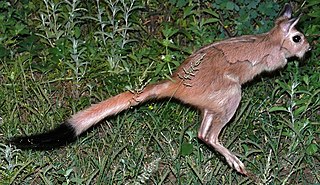
Pedetes is a genus of rodent, the springhares, in the family Pedetidae. Members of the genus are distributed across southern and Eastern Africa.
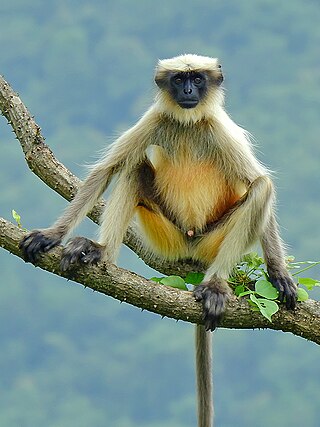
The Colobinae or leaf-eating monkeys are a subfamily of the Old World monkey family that includes 61 species in 11 genera, including the black-and-white colobus, the large-nosed proboscis monkey, and the gray langurs. Some classifications split the colobine monkeys into two tribes, while others split them into three groups. Both classifications put the three African genera Colobus, Piliocolobus, and Procolobus in one group; these genera are distinct in that they have stub thumbs. The various Asian genera are placed into another one or two groups. Analysis of mtDNA confirms the Asian species form two distinct groups, one of langurs and the other of the "odd-nosed" species, but are inconsistent as to the relationships of the gray langurs; some studies suggest that the gray langurs are not closely related to either of these groups, while others place them firmly within the langur group.
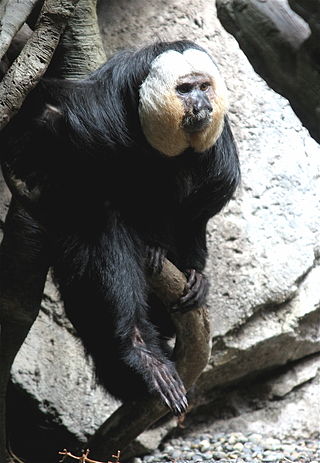
Sakis, or saki monkeys, are any of several New World monkeys of the genus Pithecia. They are closely related to the bearded sakis of genus Chiropotes.

Slow lorises are a group of several species of nocturnal strepsirrhine primates that make up the genus Nycticebus. Found in Southeast Asia and nearby areas, they range from Bangladesh and Northeast India in the west to the Sulu Archipelago in the Philippines in the east, and from Yunnan province in China in the north to the island of Java in the south.

Paranthropus aethiopicus is an extinct species of robust australopithecine from the Late Pliocene to Early Pleistocene of East Africa about 2.7–2.3 million years ago. However, it is much debated whether or not Paranthropus is an invalid grouping and is synonymous with Australopithecus, so the species is also often classified as Australopithecus aethiopicus. Whatever the case, it is considered to have been the ancestor of the much more robust P. boisei. It is debated if P. aethiopicus should be subsumed under P. boisei, and the terms P. boisei sensu lato and P. boisei sensu stricto can be used to respectively include and exclude P. aethiopicus from P. boisei.

The kipunji, also known as the highland mangabey, is a species of Old World monkey that lives in the highland forests of Tanzania. It was independently discovered by researchers from the Wildlife Conservation Society, the University of Georgia, and Conservation International, in December 2003 and July 2004, making it the first new African monkey species discovered since 1984. Originally assigned to the genus Lophocebus, genetic and morphological data showed that it is more closely related to the baboons than to the other mangabeys in the genus Lophocebus. Scientists subsequently assigned it to a new genus, Rungwecebus, named after Mount Rungwe. The kipunji is the first new monkey genus discovered since Allen's swamp monkey in 1923.
Deltaretrovirus is a genus of the Retroviridae family. It consists of exogenous horizontally transmitted viruses found in several groups of mammals. As of 2023, ICTV lists under this genus the Bovine leukemia virus and three species of primate T-lymphotropic virus.
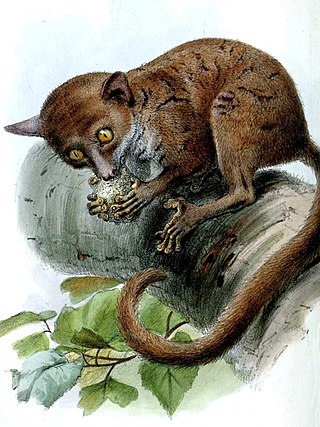
The western dwarf galagos are a group of three species of strepsirrhine primates, native to western and central Africa. They are classified in the genus Galagoides of the family Galagidae. The eastern dwarf galagos have been moved to their own genus, Paragalago, based on genetic evidence and differences in vocalization. The two genera are not sister taxa and thus may have evolved their small sizes via parallel evolution. They are separated by the East African Rift.
Ceratotherium mauritanicum is a species of fossil African rhinoceros found in the Late Pliocene to early Late Pleistocene of Morocco, Tunisia, and Algeria. It is disputed as to whether remains from the Pliocene of East Africa belong to this species, and if so, whether C. mauritanicum is ancestral to the modern white rhinoceros. During the early Late Pleistocene, sometime between 120,000–57,000 years ago, it was replaced in North Africa by the modern white rhinoceros.
Mioclanis is an extinct genus of moths in the family Sphingidae, containing one species Mioclanis shanwangiana which is known from Shandong in China. It is dated to the Middle Miocene, approximately 15 to 17 Myr.

Lemurs were first classified in 1758 by Carl Linnaeus, and the taxonomy remains controversial today, with approximately 70 to 100 species and subspecies recognized, depending on how the term "species" is defined. Having undergone their own independent evolution on Madagascar, lemurs have diversified to fill many ecological niches normally filled by other types of mammals. They include the smallest primates in the world, and once included some of the largest. Since the arrival of humans approximately 2,000 years ago, lemurs have become restricted to 10% of the island, or approximately 60,000 square kilometers (23,000 sq mi), and many face extinction. Concerns over lemur conservation have affected lemur taxonomy, since distinct species receive increased conservation attention compared to subspecies.
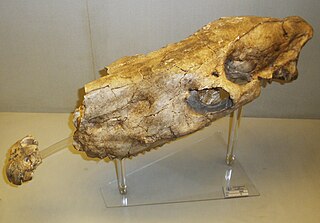
Eurygnathohippus is an extinct genus of hipparionine horse. The majority of known fossils of members of this genus were discovered in Africa, where members of this genus lived during the late Miocene to Pleistocene interval. Fossils of Eurygnathohippus were also reported from the late Pliocene sediments of the Potwar Plateau in Pakistan and the Siwalik Hills in northwest India.

Panopsis is a genus of trees in the family Proteaceae. The species, which occur in Central and South America, include: Newer species that can be considered part of the Panopsis genus has been discovered recently, called Panopsis magnifruta. Common areas where Panopsis species are seen to grow in are described to have elevated groundwater levels.

Allochrocebus is a primate genus including the terrestrial guenons: the L'Hoest's monkey, the Preuss's monkey, and the sun-tailed monkey.

Serengetilagus is a genus of lagomorph in the family Leporidae. It lived in the Pliocene of Kenya and Tanzania and the Late Miocene of Chad. Serengetilagus is the best-represented taxon from Laetoli, with approximately 34 percent of fossils in the Laetolil Beds attributed to this genus. Additional specimens from Angola, Morocco and Ukraine may also belong to this genus. It had a number of specific features unknown in other lagomorphs, such as a "missing" mesoflexid on its third premolar.
Ultrapithecus is an extinct genus of oldfieldthomasiid notoungulate that lived during the Middle Eocene of what is now Argentina.

















